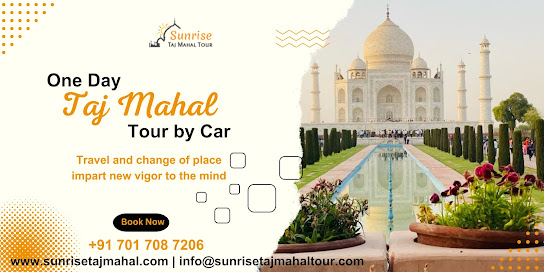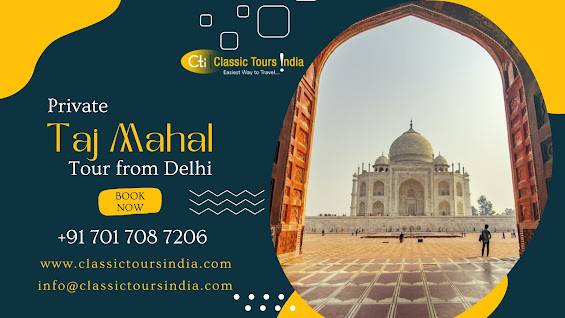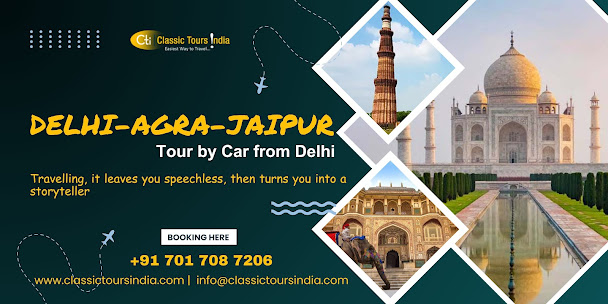

Embark on a journey to one of the most iconic landmarks in the world with the Taj Mahal and Agra Tour by Car from Delhi. Prepare to be captivated by the sheer magnificence and exquisite beauty of this architectural masterpiece. Standing tall in all its splendor, the Taj Mahal is a testament to the eternal love between Emperor Shah Jahan and his beloved wife Mumtaz Mahal.
A Taj Mahal and Agra Tour by Car from Delhi is not just a sightseeing experience; it is a journey into the heart of India’s rich cultural heritage. From the moment you step foot inside the complex, you will be enveloped in a sense of wonder and awe. Whether you are an architecture enthusiast, a history buff, or simply seeking a magical experience, a visit to the Taj Mahal will leave an indelible mark on your soul.
As you explore the Taj Mahal, you will be immersed in its fascinating history and exceptional craftsmanship. Marvel at the intricate details of the marble facade, adorned with precious gemstones, and be transported to a bygone era. The delicate minarets, reflecting pools, and meticulously manicured gardens create a serene and ethereal atmosphere, offering the perfect backdrop for capturing timeless memories.
Come, explore the Taj Mahal, and witness the allure of this sublime wonder of the world.
The Taj Mahal, often referred to as the “Crown of Palaces,” was built by Emperor Shah Jahan in the 17th century as a mausoleum for his beloved wife, Mumtaz Mahal. The construction of this architectural marvel began in 1632 and took 22 years to complete. The Taj Mahal is a symbol of everlasting love and a monument to the grief-stricken Emperor’s devotion to his wife.
The significance of the Taj Mahal extends beyond its romantic origins. It is recognized globally as a UNESCO World Heritage Site and is considered one of the New Seven Wonders of the World. Its architectural brilliance and cultural significance make it an integral part of India’s rich history and heritage.
The Taj Mahal is not just a physical structure but a testament to the Mughal era’s grandeur and artistic prowess. Its construction involved thousands of skilled craftsmen, including architects, calligraphers, and artisans, who meticulously created every intricate detail of this masterpiece. The Taj Mahal’s architectural style is a fusion of Persian, Islamic, and Indian influences, resulting in a harmonious blend of elements.
The Taj Mahal’s architecture and design are nothing short of breathtaking. The entire complex is a symmetrical masterpiece, with the mausoleum at its center and four minarets at each corner. The mausoleum’s main structure is made of white marble, which changes its color with the varying intensity of sunlight. The intricate carvings and inlay work, known as “pietra dura,” are made from precious gemstones, including jade, crystal, turquoise, and lapis lazuli.
The Taj Mahal’s main dome is its most striking feature, rising to a height of 73 meters and crowned with a golden finial. It is surrounded by four smaller domed chhatris, which enhance the overall architectural balance. The minarets, standing at a height of over 40 meters, not only serve as decorative elements but also provide a sense of scale and grandeur. The entire complex is surrounded by lush green gardens, meticulously laid out in the traditional charbagh style, symbolizing paradise.
The Taj Mahal’s architectural brilliance lies in its perfect symmetry and intricate detailing. The use of geometric patterns, calligraphy, and floral motifs creates a visually stunning masterpiece that has stood the test of time.
The Taj Mahal’s construction required the labor of approximately 20,000 workers, including artisans and craftsmen from all over the world. The white marble used to build the Taj Mahal was transported from Makrana, Rajasthan, a distance of over 300 kilometers. The Taj Mahal appears to change color depending on the time of day. It appears pinkish in the morning, milky white in the evening, and golden under the moonlight. The calligraphy on the Taj Mahal’s facade is not painted but carved into the marble. It is said that the calligraphers used precious gemstones to create the intricate patterns. The Taj Mahal is an architectural marvel, designed to withstand earthquakes. The minarets are built slightly outward, so in the event of an earthquake, they would fall away from the main structure and protect it from damage.
Inside the mausoleum, you will find the cenotaphs of Emperor Shah Jahan and Mumtaz Mahal, beautifully decorated with inlaid gemstones. The actual tombs are located in the lower level, which is not open to the public. The interior of the mausoleum is adorned with intricate floral motifs and calligraphy, depicting verses from the Quran.
As you explore the Taj Mahal complex, take a leisurely stroll through the lush gardens and enjoy the serene ambiance. The reflecting pools, known as the “Pond of Paradise,” offer a picturesque view of the Taj Mahal’s reflection, especially during the early morning hours.

In India, there are so many cities to explore, but these three cities are the most popular: Delhi, Agra, and Jaipur. Delhi is the capital of India; Agra is the city of love, or the Taj, which is included in the 7 wonders of the world; and the last and most beautiful city is Jaipur, the city of forts, also known as Pink City. This mesmerising tour became more exciting when the Sunrise Taj Mahal Tour added Tiger Safari. The Golden Triangle Tour with Ranthambore is a budget-friendly tour.
This tour will start in Delhi, go through Agra, Fatehpur Sikri, Ranthambore, and Jaipur, and then return to Delhi. It will take you 7 nights and 8 days.
Our representative will pick you up from the location as per your requirement, whether it is an airport, a hotel, or any specific location.
Your first location is the capital of India, Delhi. When you arrive at Delhi’s airport, our representative will pick you up from there and drop you off at your pre-booked hotel. You must take a rest over the night in the hotel and prepare for the next day’s morning Delhi Sightseeing Tour.
Rest over the night; you have to take a morning meal and then continue your local sightseeing in Delhi. Visit Qutub Minar, the tallest brick minaret in the world and a UNESCO World Heritage Site; Lotus Temple; and the Humayun tomb, which is the tomb of Mughal Emperor Humayun.
After visiting these sites, take a delicious lunch at a luxury restaurant according to your budget that we have already booked.
After that, you can visit the President House, the National Museum, Lakshmi Narayan Mandir, Raj Ghat, India Gate, and Chandni Chowk Market.
In the evening, we are planning the evening’s tour for those people who are excited to see the light show at India Gate as part of the Delhi Evening Tour.
After this mesmerising tour, you are ready for another memorable Agra tour. Now, leave Delhi and go to Agra for your next location on your tour.
Your second location is the city of Taj, Agra. Delhi to Agra is too far, so you must take a rest at a pre-booked hotel in Agra. Your tour will start early in the morning, but first you have breakfast and then visit your magnificent Taj Mahal Tour. The Sunrise Taj Mahal Tour is a specialised tour for those who want to see the mesmerising beauty of Taj Mahal in the morning. It changes its colour in the morning; it has a pink or light yellow colour, so that’s why people want to see the Taj Mahal in the morning.
Taj Mahal was built by Shah Jahan in 1636–1648 for his beloved wife, Mumtaj, who died while giving birth. It was made of precious marble, which we called Makrana marble; it is in Makrana rajasthan.
Take your lunch and explore many monuments like baby Taj, Agra Fort, Mehatab Bagh and many more.
You must buy things that showcase their craftsmanship and architecture very beautifully. Here you will find many things made with hand work, such as making intricate designs on marble and turning it into a beautiful marble table and making carpets with great detail using hand work.
After visiting Agra and the Taj Mahal, you will depart from Agra to Fatehpur Sikri. It lies just east of the Rajasthan state border, about 23 miles (37 km) far from Agra. Fatehpur Sikri, (Ghost Town) is one of the UNESCO World Heritage Sites and was founded as the capital of the Mughal emperor in the 16th century by emperor Akbar. It was made of red sandstone. At the entrance of the monuments, there is a large gate called Buland Darwaza, which has calligraphy on it. The monument has a Jama Masjid, the Tomb of Salim Chisti, Diwan-e-khas, Jodha Bai’s palace, Panch Mahal, and many stories.
Ranthambore National Park covers an area of around 392 sq km. This park is majorly famous for its tigers, and it is the best for those who love to see the majestic predators in their natural habitat. Enjoy morning and afternoon wildlife safaris with Jeep and Canter. In Ranthambore, there is the temple of Lord Ganesha, which is known as the Trínetra Ganesha Temple.
The last and final place to visit Jaipur is known as the city of Forts, or Pink City,Going through Jaipur via road trip. you must take a rest overnight and be ready for your next day’s Jaipur Sightseeing Tour. Jaipur is the perfect example of heritage culture and beautiful Indian art architecture work.
Wake up early in the morning and eat breakfast, then go and visit the beautiful monuments.
After taking a morning meal, your first location is Amber Fort, which is situated at the height of Aravali Hill and offers an elephant ride in the fort. The next location is the city palace, which is a building built by Rajputs that is remarkable. You may visit other monuments like Jaal Mahal, Hawa Mahal, Jantar Mantar, and many more according to your time.
Enjoy your magnificent lunch in the luxury restaurant that we have already booked as per your budget.
If you want to shop for something like Rajasthani culture dresses, handcrafted things, and many more, our representative will help you with your shopping.
It is time to say bye-bye to your memorable and beautiful Golden Triangle Tour with Ranthambore. We are sure that you will never forget this mesmerising tour of your entire life. It is a budget-friendly tour with lots of memories. It is a perfect tour example to learn about Indian culture and heritage monuments.
If you are a first-time traveller in India, you should plan this Delhi Agra Jaipur Tour with Ranthambore.
India’s monuments are the masterpiece of architecture in terms of impression, treatment, execution, and implementation, and it has a unique exquisite character in terms of balance, elegance, and successful collaboration among many elements.



To make the most of your Private Taj Mahal Tour from Delhi, it’s important to choose the best time to visit. The monument is open year-round, but certain months offer more favorable weather conditions and fewer crowds. The winter months, from October to March, are considered the best time to visit as the weather is pleasant, and the days are sunny. However, it’s important to note that this is also the peak tourist season, so expect larger crowds during this time.
Most people are coming to see the Taj Mahal in the morning with the Sunrise Taj Mahal Tour From Delhi by Car, which is the most bookable tour.
To make the most of your Private Taj Mahal Tour from Delhi, here are a few tips to keep in mind:


This enchanting tour takes you through the golden triangle of India, allowing you to explore three of the country’s most iconic cities: Delhi, Agra, and Jaipur. Embark on a mesmerizing journey through history and culture with the Delhi Agra Jaipur Tour by Car from Delhi.
The Delhi Agra Jaipur Tour is filled with incredible highlights that showcase the rich history, architectural wonders, and cultural heritage of India. This tour offers a perfect blend of ancient and modern attractions, ensuring a memorable experience for every traveler.
Afterward, make your way to the Lotus Temple, a stunning architectural masterpiece renowned for its unique lotus-shaped design. This Bahá’í House of Worship welcomes people of all religions and provides a serene atmosphere for meditation and reflection. Take a moment to appreciate the tranquil surroundings and soak in the spiritual energy of this place.
No visit to Delhi is complete without exploring the bustling Chandni Chowk market. This vibrant marketplace is a paradise for shopaholics and food enthusiasts alike. Lose yourself in the narrow lanes filled with shops selling everything from traditional jewelry and textiles to mouth-watering street food. Indulge in local delicacies like chaat, kebabs, and sweets, and experience the true essence of Delhi’s culinary delights.
Agra, a city steeped in romance and architectural marvels, is the next stop on your tour. The highlight of Agra, and perhaps the entire tour, is the magnificent Taj Mahal Sunrise Tour. Built by Emperor Shah Jahan as a mausoleum for his beloved wife, Mumtaz Mahal, this ivory-white marble masterpiece is a symbol of eternal love. As you approach the Taj Mahal, prepare to be awestruck by its sheer beauty and grandeur. Marvel at the intricate marble inlay work, the delicate carvings, and the symmetrical gardens that surround this UNESCO World Heritage Site.
Continuing your journey to Jaipur, the vibrant capital of Rajasthan, you will be transported to a bygone era of opulence and valor. Known as the “Pink City” due to its pink-hued buildings, Jaipur is a visual delight with its stunning palaces, majestic forts, and bustling markets.